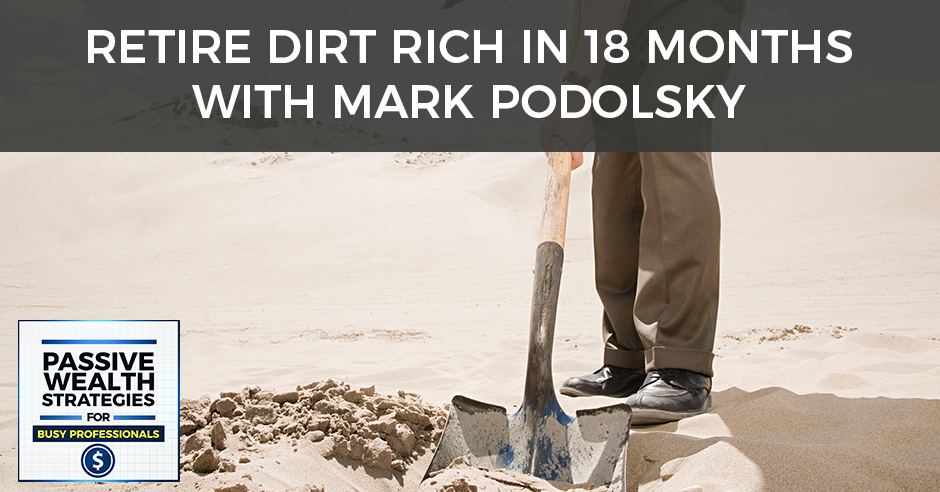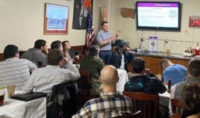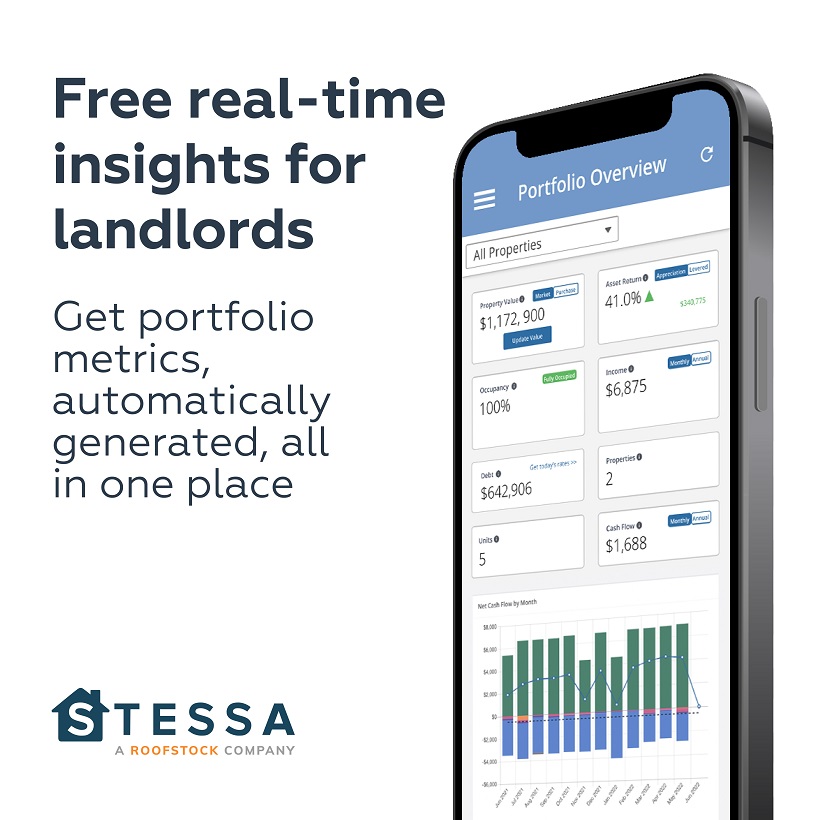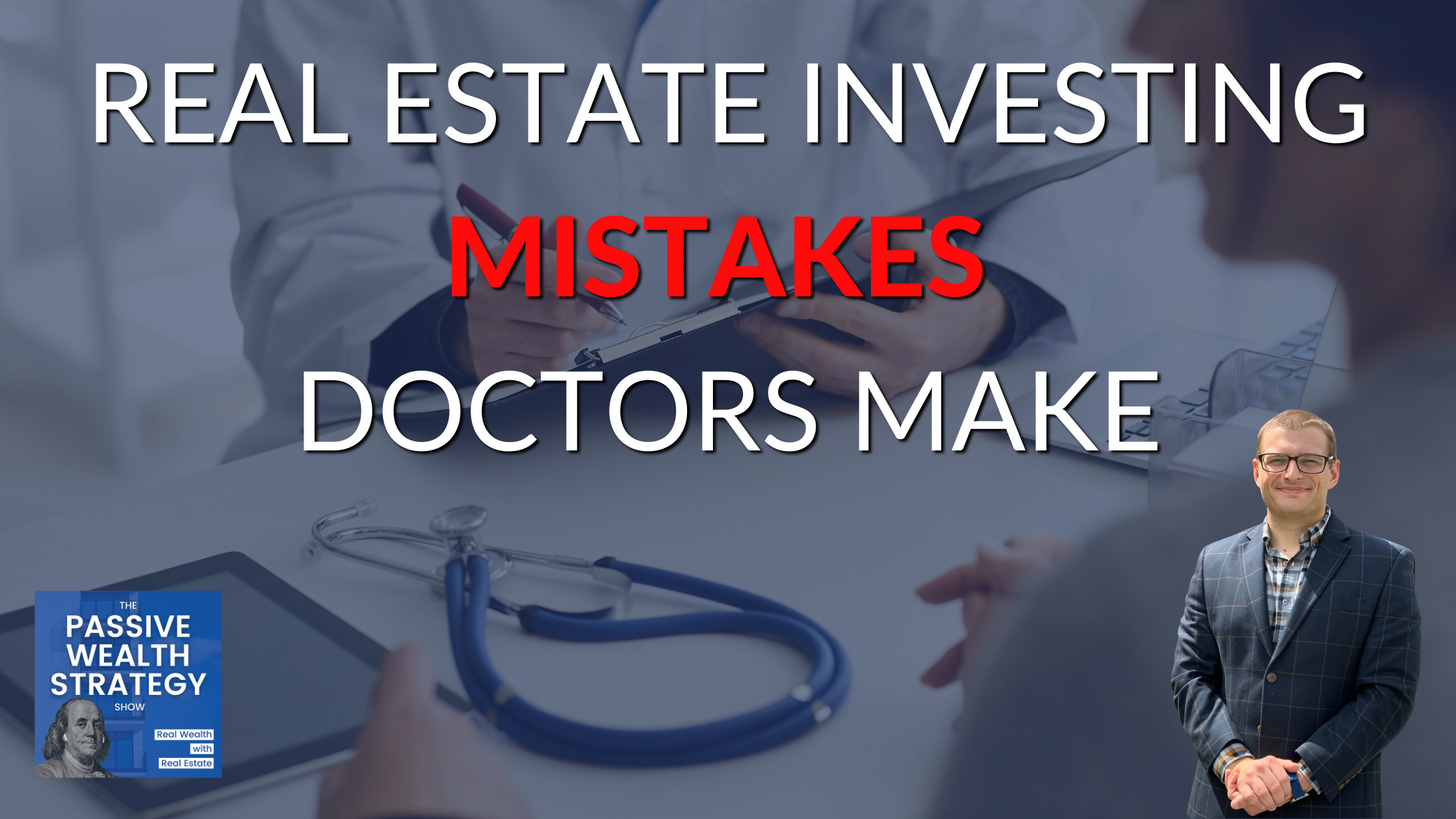How can you retire dirt rich? Mark Podolsky, the owner of Frontier Properties and author of Dirt Rich, walks us through his model of doing land deals that helps you retire dirt rich. Mark has been buying and selling raw land full time since 2001 and has completed over 5,000 land deals. Check out how passive land investing can work out for you as Mark walks us through land investing and how to make money off of dirt! Mark stresses the value of due diligence and hard work because land investing takes real work, but the payoff is huge.
—
Retire Dirt Rich in 18 months with Mark Podolsky
Our guest is Mark Podolsky. Mark is the owner of Frontier Properties, a reputable and successful land investing company. Mark has been buying and selling land full time since 2001. He has completed over 5,000 land deals by focusing on working smart, not hard. His deals have an average ROI of over 300% on cash flips and over 1000% on the deals he sells with financing terms. Prior to his land investing success, Mark had high stress, soulless corporate job and felt trapped in his state of solo economic dependency. It’s something you might relate into. Escaping solo economic dependency changed Mark’s life in many positive ways that he decided to teach, coach and mentor others to help them achieve their financial goals.
Even though Mark invests a lot of his time in helping others, he stays actively involved in running his land investing business and is dedicated to teaching the most current and relevant real-world land investing methods to his students. He wrote a book, Dirt Rich: How One Ambitiously Lazy Geek Created Passive Income in Real Estate Without Renters, Renovations, and Rehabs. You can find it on Amazon. You can listen to him on his podcast, The Art of Passive Income podcast. It’s something I know all of our audience will be interested in. We’re going to talk a little bit more about passive land investing and why we should get into this asset class. Mark, welcome to the show.
Taylor, thanks so much for having me. I appreciate it.
Many of our audience are multifamily investors. They have a background, they understand a little bit about syndication, but maybe they don’t know about how to do land deals. Can you give us a quick primer on how we can get started investing in dirt?
Let me walk you through the entire model, start to finish. Taylor, where do you live?
I live in Richmond, Virginia.
You’re Richmond, Virginia. For our purposes, we’re going to pretend that you owe $200 in back taxes on a ten-acre parcel in Texas. I’m going to call the treasurer. I’m going to get the list of people that owe back taxes in this county in Texas. There’s Taylor, he owes $200 in back taxes on his ten-acre parcel. Taylor, you’re advertising two things for me. Number one, you have no emotional attachment to that raw land. You’re in Richmond, Virginia. The property is in Texas. Number two, you’re distressed in some way because when we don’t value something, we don’t pay for it. I don’t know what’s going on, but you haven’t paid your taxes. You’re getting notices from the treasurer every month or every quarter saying that if you don’t pay these taxes, you’re eventually going to lose that property to a tax lien investor or a tax deed investor.
What I’ll do is I’ll look at the comparable sales on that ten-acre parcel. Let’s say for the last eighteen months, I see it’s $10,000. All I’m going to do is divide by four. That’s going to get me what Warren Buffett would call a 300% margin of safety. I’m going to send you an actual offer. I don’t want to be the housing guys. I don’t want to be in the appraisal business. I’m going to send you an actual offer of $2,500 for your ten-acre parcel. You’re going to accept it because if you don’t accept it, you’re eventually going to lose that property. In reality, 3% to 5% of people accept our top dollar offer.
Before I buy that property from you for $2,500, I’m going to go through due diligence or research. Number one, I’ve got to confirm that you own the property. Number two, I’m going to confirm that the back taxes are only $200. Number three, I want to make sure that there’s an ingress or egress legal access. Number four, I want to make sure there’s something compelling about the property. Are you near a stream? Are there mountain views? Is it treed? What’s going on over there? Are you in the path of growth? What can I do on the property? I’m going to get GIS maps. I’m going to get plat maps. I’m going to get all this information during my due diligence. At the same time, I’m making my marketing package because all the information that I’m getting, a buyer is going to want to know as well.
The economy is good so people are feeling good. Click To TweetI go through my entire due diligence checklists. Everything checks out. What I’ll do is I’ll buy that property from you for $2,300 so that’s $2,500 net for that property. Now, Taylor, I have a built-in the best buyer. Do you know who’s going to buy that property? It’s the neighbors. I’m going to send out neighbor letters saying, “Before I go to the open market, here’s your opportunity. Protect your view, protect your privacy and expand your holdings.” Oftentimes, the neighbors will buy that property. If the neighbors pass, I’m going to go to my buyer’s list. If my buyer’s list passes, I’m going to a little website you’ve probably never even heard of called Craigslist. It’s the tenth most trafficked websites in the United States. I’m going to go to another little website you’ve probably never heard of called Facebook.
If it was a country, it’d be like the third largest country. I’m going to buy and sell groups. I’m going to sell this property in 30 days or less. The way that I’m going to do it is I’m going to make it irresistible. I’m going to ask for $2,500 down payment on that property. I get my capital out on day one or maybe within six months. It doesn’t matter. I usually won’t go out any longer than six months. I’m going to get a car payment. Let’s say it’s $449 a month at 9% interest over the next 84 months. What I’ve done now is I’ve gotten my money out. I’ve created a passive income stream of $449 a month for the next 84 months. Taylor, I don’t have to deal with any renters, rehabs, renovations or rodents. Because I’m not dealing with a tenant, I’m exempt from Dodd-Frank, RESPA or The Safe Act, all this onerous real estate legislation. The game that we play is can we create enough of these passive income notes where that passive income stream exceeds our fixed expenses? We’re working because we want to, not because we have to.
You’re buying say parcels that have a distressed owner or somebody is not paying their taxes or maybe there’s a mechanics lien or something. There’s some reason, some indicator that they don’t want this property and they’re out of state. They’re most likely not making any use of the property. You approach them, get it under contract for an attractive price and resell that contract to another potential buyer like a neighbor or maybe somebody by certain examples might want a parcel to hunt on during hunting season or something along those lines. It’s somebody else who’s going to enjoy it more. That gives you that coupon payment over time until they pay off the property.
What’s awesome about this model is it’s 90% automated with software all the way from sending out the offers, doing our due diligence all the way to the marketing. We use a program called GeekPay.io. That is a set it and forget it system to get the down payment and get their ACH payments every single month. It does all the notifications. They can go in and make a prepayment anytime. It’s incredible. It’s saved me so much time.
It sounded like as you’re going through the model, there’s a lot of work upfront getting the data and scrubbing the data so you get to the point where you find potential people you can send letters to. Determine what the attractive price might be that you can come out and offer them. You send them letters. You said you get a 3% to 5% acceptance rate on those first offers. It sounds like there’s a quite a bit of volume involved here and a lot of letters to send.
We want to send out about twenty a day because that’s easy to do. If we do it through automation, it takes about two seconds to do. It’s simple in that regard. Twenty a day, 140 a week, let’s say 400 a month, if we’re taking 3% of that, that’s about twelve deals a month. It’s about 144 deals minimum a year.
Can you tell me a little bit about what the automation looks like? When I think automation, there are tools that’ll do things automatically. It’s a computer doing the work. There are virtual assistants, for example. I use virtual assistants for this podcast to do social media, editing and things like that. Are you using virtual assistants to scrub the data? What is the automation look like? What are the nuts and bolts?
The first piece is getting the list. We have a team in the Philippines of about twelve trained virtual assistants that run the business for me and my clients. They don’t have to go out, hire and train a virtual assistant. It’s a plug and play for them. The first part is getting that list. It’s scrubbing that list. It’s uploading it into our proprietary software. We’ve created this software for ourselves that are dedicated to our business. We use an API with a company called Lob.com. Lob sends out the offer letters. When they come back out, we have our intake manager screen the seller because sometimes the sellers will want to call or talk about the offer. They just want to yell at us. Sometimes they want to sell. The intake manager makes sure that it’s a real deal.
Once the intake manager qualifies the seller then that goes to our acquisition manager. The acquisition manager walks that seller through the process of this is what it’s going to take for due diligence. This is where we’re going to close and closes the deal. We use a company called Simplifile so that we can record electronically. We record the deed electronically with Simplifile. We own the property. We go through and we have our VAs in the Philippines create the data for sending out neighbor letters that are automated. It goes through the marketing piece. The software walks you through where are we marketing because we want the data of the Pareto principle. If we know that 80% of our deals right now for this colony are closing at Facebook, we want to market heavily on Facebook.

If 80% are closing on Craigslist, then Craigslist or our buyer’s list or whatever that is. We want to get good data, where is that property selling? Once it goes to marketing, we again have our virtual assistants make us ubiquitous and do the marketing. We use a program called PostingDomination.com/TheLandGeek. I can create about 64 ads by pressing a button. It automates through Craigslist and Facebook without getting flagged. We’re automating it with software on the marketing piece. Now once we start dealing with our buyers, that’s where our intake manager is going to provide all the marketing package, get on the phone with them and close the deal. The acquisition manager uses GeekPay.io to close the deal. They’ll send them a link and the Set It, Forget It system and do all the contracts, which is again through our software. It used to take me twenty minutes to do all the contracts, the promissory note, the land sale contract and the purchase-sale agreement. Now, it takes about one second to do. The theory is I can always make more money, but I can’t get more time. Anything that will save me time, whether it’s software or a virtual assistant, I will use.
To pick on the example that you provided, you said, I live in Richmond obviously. You picked on Texas. I own a hypothetical parcel in Texas. Why Texas? Are there markets that you’re targeting or states or areas that are ideal for going towards, approaching owners and areas that are less good. How do you parse it? It’s a big country.
There are 3,007 counties in the US. There are billions of raw land for sale. Nobody wakes up, Taylor and thinks to themselves, “I’d love some raw land in Iowa,” unless you live in Iowa. Let’s say the Southwest, Arizona, Colorado, New Mexico and Nevada, Texas, California, a little bit in the Northwest, Washington, Oregon, and Florida. That’s where we’re going to spend the majority of our time. I’ve done deals in the Midwest. I’ve done deals a little bit on the East Coast. Number one, if I’m going to do deals, let’s say in Pennsylvania or New Jersey, I got to worry about Super Fun sites. The due diligence in those areas is so much more complicated based on environmental issues than these pristine areas in the Southwest, West Coast, and the Northwest. We want to focus on those areas. That’s going to be our biggest buyer pool.
I grew up in Pennsylvania. I’m certainly familiar with many of the environmental issues going on there. That’s a great example of why you might not want to go to a particular area. As far as the bottleneck in this business model, is the limiting factor the number deals you’re able to get under contract? Do you have a reasonably easy time finding buyers or is it the other way around? You have a lot of deals that you can’t find buyers for these days. What would you say on balance that market looks like?
It’s easy to sell and it’s getting more difficult to buy because there are less distressed owners out there. The economy is good so people are feeling good. They’re either paying their taxes or they feel like, “I don’t need the money right now so I’m not going to necessarily sell the property.” Now that being said, we’re still doing deals. It’s a little bit tougher. Back in 2010, it was easy to buy but a little bit more difficult to sell. People were more fearful. They wanted to hold onto their capital. Right now we have pretty good equilibrium, but I’m saying it’s tipping over into, it’s way easier to sell than it is to buy.
For our audience out there that’s thinking, “This sounds great. I want to get involved and how long is it going to take me to replace my $200,000 a year income from my job. If I want to dive head on into this business in my free time, continue and eventually leave my job, how long is that going to take?”
It depends on the person. It took me eighteen months. I was an investment banker for the land investing income to exceed my investment banking income. Scott Todd, it took him seventeen months and three days. He’s a Fortune 500 exec. It took him that long. We’ve Mimi Schmidt. It took her three years. She works for the Department of Defense. She had a big job. She managed 150 people in their counter-terrorism unit. She was working 60 hours a week. When she could, she’d work an hour to about a day in her land investing business. It took her three years. Rachel and Sean Mueller don’t have kids. It took them about sixteen months for them to be able to quit their software engineering job and sales job. Now they’re traveling around the world on their passive income and doing land deals. That’s the other great thing about this model is it’s scalable. You need an inexpensive laptop and an internet connection. You can do it from anywhere in the world.
To get started, say people want to maybe explore or learn a little bit more in depth, what’s it take to say dip a toe in the water and give it a shot?
The best place to go is TheLandGeek.com. They can download our resources for free. They can get the passive income blueprint. They can get our eBook, How To Avoid the Three Fatal Land Buying Mistakes. They can also get a bunch of other tools as well. They can get Dirt Rich on Amazon and start there. Doing a lot of research as well from there. I’d say you’d want to learn the business from someone who’s already done it. If I’m going to go up Mount Everest, I want a Sherpa who’s already done it a million times. That’s what I would say is going to be the best place to go. Get those resources for free and determine if it’s a good fit for you or not.
You can always make more money, but not more time. Anything that will save time, whether it's software or a VA, is recommendable. Click To TweetWhat about for the people out there who maybe have a couple of bucks in their bank account? They don’t want to start a new business, but they’re interested in this as a vehicle to make returns. As I read in the beginning from your bio, you hit 300% to 1000% returns depending on the deal structure. Is there any space to get involved for someone who has a couple hundred thousand in dollars in capital to partner up with someone else who’s exploring this model?
If you’re an accredited investor, you can contact our office or email me directly. You can email [email protected]. We have a fund. We would do that for them.
Mark, what is the worst investment you ever made?
The worst investment I ever made was in your home state of Pennsylvania. It was a gated community. There are million-dollar homes in there, two PG-rated golf courses, three beautiful lakes. There’s an expensive HOA or Homeowners Association or what they call POA, Property Owners Association. It’s 2005 and I’m going in there and saying, “You’ve got all these lots and they’ve got liens on them,” because the POA was putting liens on people that weren’t paying the POA fees. It was overdeveloped. It’s 1,000 lots. I go to the county and say, “You’ve got all this dead money. Nobody is paying the taxes. Give me these lots. I will sell them for you. I’m going to get you a new owner. They’re going to pay the POA fees. They’re going to pay the property taxes. I’m going to make a little bit of money in the process.”
I’m flying back and forth and negotiating with the county. I’m negotiating with the attorneys with the POA. We closed a deal in 2006. I’m paying nothing for these lots, like $50 a lot. I bought them all at once. Instead of doing what I would say would be the smart thing to do, which had been a takedown deal buy ten, sell ten, buy another ten and lock them all up. I wasn’t using a mentor at that time because I was so full of myself. I thought I was the smartest guy in the room. That was a huge mistake. 2006 comes around, in 2007 things started slowing down, and we all know what happened in 2008. It was the first time in a business that I wasn’t able to fulfill a promise that I made to these people. It was terrible. Even though I made $100,000 on the deal, when I factored in my time, it’s the first deal I ever broke even on. It’s not great.
That’s quite the story. That’s a good worst investment. How about what is the best investment you ever made?
The best investment I ever made, I bought several hundred thousand acres from the railroad in Nevada. It’s a long and complicated story. What I did was I took the 640-acre sections. I subdivided them into 40-acre parcels and over the next four to five years, I made over $5 million.
How did that happen? How did that come about? Where did you find that deal?
Basically, it’s just doing good research. I negotiated with the company that owned all that property. They weren’t interested in the land. They were more interested in mineral rights. We said, “Keep the mineral rights.” We bought all the property. We subdivided. We paid on average about $50 an acre and sold it for $500 an acre.

What is the most important lesson you’ve learned in your investing career?
It’s humility. I said this to my kids all the time, “I don’t know anything about anything.” I never think about my best deal. I don’t think about how much cashflow we have coming in every month. I don’t celebrate. I’ve always wanted to stay grounded in humility and be open minded. I’m constantly asking myself the Jeff Bezos question, “If everything is going to change, what’s not going to change?” In my business where I don’t think is going to change is I still think people are always going to want a real asset. They’re always going to want a great deal.
As long as those fundamental principles hold true, I’m going to stay in this business. I’ve been doing it full time since 2001. Every day I want to stay humble to the fact that I don’t know anything. Don’t get pigeonholed by expertise. Don’t drink your own Kool-Aid. I’ve had my clients, the same county as me, send out offers 20% less because they didn’t know what they were doing. I’m like, “They’re getting better deals than me because they don’t know.” They don’t know better. You’ve got 640 acres for $15,000. He flipped it for $150,000 that’s not supposed to happen. I would never even offer $15,000. It’s being open-minded and not being trapped by my own expertise.
I certainly appreciate all of those answers. Do you have anything else to add for the audience?
I’d love to give them a gift. If they go to TheLandGeek.com/LaunchKit, they can register for our $97 passive income launch kit course for free. It’s TheLandGeek.com/LaunchKit.
Mark, thank you for joining us. I certainly encourage our audience to go check out your podcast, pick up the book. The name of the podcast is The Art of Passive Income. How can people get in touch with you?
Taylor, the best place to go is TheLandGeek.com.
To our audience, thank you for tuning in. If you’re enjoying the show, please leave us a rating in iTunes. That’s a big help. Share with a friend. We’ll talk to you on the next one.
Important Links:
- Frontier Properties
- Dirt Rich: How One Ambitiously Lazy Geek Created Passive Income in Real Estate Without Renters, Renovations, and Rehabs
- The Art of Passive Income podcast
- GeekPay.io
- Lob.com
- Simplifile
- PostingDomination.com/TheLandGeek
- TheLandGeek.com
- [email protected]
- TheLandGeek.com/LaunchKit
- iTunes – Passive Wealth Strategies for Busy Professionals
- How To Avoid the Three Fatal Land Buying Mistakes
About Mark Podolsky

Like several of his colleagues, Mark liked the idea of investing in real estate. So the next time he earned a commission check, Mark went down to a tax sale auction at the county. He ended up buying a property with a commission from a big deal… and what’s more, Mark put everything he had into buying land in New Mexico.
“My wife thought I was crazy, he says, but I told her, ‘at least we own land.”Sure enough, Mark was able to sell all his New Mexico property at a profit. Even better, Mark was soon able to quit his job to go into the real estate business full-time.
If you are serious about earning money from buying and selling land, Mark has created a personal blueprint to show you exactly how to generate $20,000 a month in the Land Buyers Elite Coaching Program.






